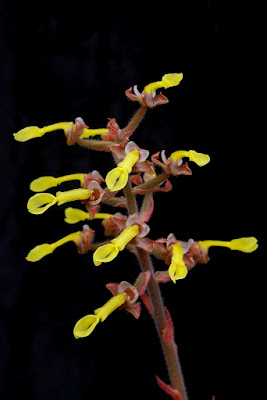Anoectochilus chapaensis - Chapa Anoectochilus has blackish green leaves with golden-red venation and lime-green to yellow flowers.
Anoectochilus chapaensis, also called as Chapa Anoectochilus, is a species of the genus Anoectochilus. This species was described by François Gagnepain in 1931.
DESCRIPTION OF ANOECTOCHILUS CHAPAENSIS - CHAPA ANOECTOCHILUS
Anoectochilus chapaensis is native to China and Vietnam. It is found growing in shaded humid places in dense forests in southeastern Yunnan province of China and northern Vietnam at elevations of 1300-1800 meters above sea level.
It is a miniature to small sized, warm to cool growing terrestrial species which reaching 12-18 cm tall with ascending or erect stems. The leaves are 3-5, ovate, oblique, acute apex, petiole-like base, 2-5 cm long by 1.5-3.5 cm wide, blackish green with golden-red venation in upper surface, pale green in lower surface, with tubular sheath.
Chapa Anoectochilus blooms in the summer on a terminal, up to 15 cm long, successive, 2-7 flowered inflorescence with 2 or 3 pale red sheathing sterile bracts and pale red, ovate-lanceolate floral bracts. The flowers are erect, not resupinate, lime green to yellow colored, ovary and pedicel narrowly cylindric, not twisted, pubescent. Sepals pubescent on outer surface, 1-veined; dorsal sepal ovate, cymbiform, apex acuminate; lateral sepals ovate-oblong, apex obtuse. Petals ovate, strongly oblique, falcate, 1-veined, apex caudate and incurved; lip white, Y-shaped; flanges oblong, pectinate, divided into 3 or 4 narrow teeth; epichile longitudinally dilated, 2-lobed; lobes diverging widely, obovate, margin crenulate, apex truncate; spur conic, apex obtuse, containing 2 calli. Column short, with 2 broad lamellate wings.
ANOECTOCHILUS CHAPAENSIS - CHAPA ANOECTOCHILUS CARE AND CULTURE
Cultural information should only be used as a guide, and should be to be adapted to suit you. Your physical location; where you grow your plants, how much time you have to devote to their care, and many other factors, will need to be taken into account. Only then can you decide on the cultural methods that best suit you and your plants.
Light:
Anoectochilus chapaensis needs a light level of 8000-15000 lux. The light should be well filtered and dispersed, and the plants should not be exposed to direct sunlight. Strong air movement should be ensured all the time.
Temperature:
In summer, the average day temperature is 27-29 °C, the night 21-22 °C, which gives a daily difference of 6-7 °C. In winter, the average day temperature is 26-28 ° C, at night 18-19 °C, with a daily amplitude of 8-10° C.
Humidity:
Chapa Anoectochilus needs the humidity of 80-90% throughout the year. Too dry air has a negative effect on the development of the plant: its growth is inhibited, and the leaves begin to turn yellow and dry out. The higher temperature, the higher the humidity should be, and the higher the humidity, the more often and longer it is necessary to ventilate the room where the plants are contained, otherwise the probability of rotting and various kinds of fungal diseases. Good air movement is essential while the plants are in leaf and growing.
Substrate, growing media and repotting:
Anoectochilus chapaensis are usually grown in shallow pots with good drainage, filled with a very loose, quickly drying ground, such as medium granulation bark or chopped tree fern fibers. Also, materials that loosen the substrate but often retain a portion of the moisture, e.g. perlite and cut sphagnum moss, are often added to such a mixture. Wood charcoal is also often added to ensure the air permeability of the substrate and protection against acidification.
The plants should be repotted when the substrate begins to decompose or grow out of the pots. If repotting is done at the time when new roots begin to appear, the plant will be accepted and rooted in the shortest possible time. These plants relatively easily reproduce from pieces of stem.
Watering:
Chapa Anoectochilus in the phase of active growth should be frequently watered, but they should slightly dry out between waterings and you can never allow the substrate around the roots to be stale or soaked. When new growths reach maturity in the autumn, the amount of water should be gradually reduced.
Fertilizer:
During the active growth, the plants should be fertilized every week 1/4-1/2 of the recommended dose of fertilizer for orchids. You can use balanced fertilizer throughout the year, but can also use fertilizer with increased nitrogen content from spring to mid summer, and then in the late summer and autumn, use a fertilizer with a higher content of phosphorus.
Rest period:
Anoectochilus chapaensis does not need a rest period to stimulate flowering, but in winter watering should be limited, especially those grown in colder conditions, but it is not allowed to dry excessively or remain dry for a long time. Fertilization should be reduced or completely eliminated until more intense watering starts in the spring.















COMMENTS